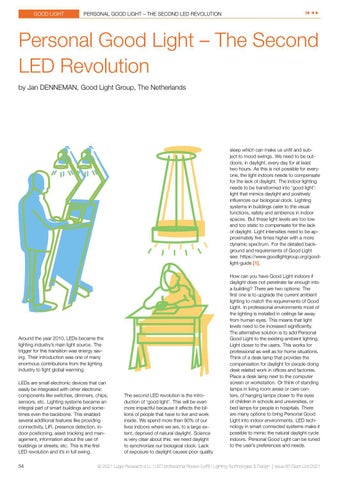GOOD LIGHT
!"#
PERSONAL GOOD LIGHT – THE SECOND LED REVOLUTION
Personal Good Light – The Second LED Revolution by Jan DENNEMAN, Good Light Group, The Netherlands
sleep which can make us unfit and subject to mood swings. We need to be outdoors, in daylight, every day for at least two hours. As this is not possible for everyone, the light indoors needs to compensate for the lack of daylight. The indoor lighting needs to be transformed into ‘good light’: light that mimics daylight and positively influences our biological clock. Lighting systems in buildings cater to the visual functions, safety and ambience in indoor spaces. But these light levels are too low and too static to compensate for the lack of daylight. Light intensities need to be approximately five times higher with a more dynamic spectrum. For the detailed background and requirements of Good Light see: https://www.goodlightgroup.org/goodlight-guide [1].
Around the year 2010, LEDs became the lighting industry’s main light source. The trigger for this transition was energy saving. Their introduction was one of many enormous contributions from the lighting industry to fight global warming. LEDs are small electronic devices that can easily be integrated with other electronic components like switches, dimmers, chips, sensors, etc. Lighting systems became an integral part of smart buildings and sometimes even the backbone. This enabled several additional features like providing connectivity, LiFi, presence detection, indoor positioning, asset tracking and management, information about the use of buildings or streets, etc. This is the first LED revolution and it’s in full swing. 54
The second LED revolution is the introduction of ‘good light’. This will be even more impactful because it affects the billions of people that have to live and work inside. We spend more than 90% of our lives indoors where we are, to a large extent, deprived of natural daylight. Science is very clear about this: we need daylight to synchronize our biological clock. Lack of exposure to daylight causes poor quality
How can you have Good Light indoors if daylight does not penetrate far enough into a building? There are two options: The first one is to upgrade the current ambient lighting to match the requirements of Good Light. In professional environments most of the lighting is installed in ceilings far away from human eyes. This means that light levels need to be increased significantly. The alternative solution is to add Personal Good Light to the existing ambient lighting. Light closer to the users. This works for professional as well as for home situations. Think of a desk lamp that provides the compensation for daylight for people doing desk related work in offices and factories. Place a desk lamp next to the computer screen or workstation. Or think of standing lamps in living room areas or care centers, of hanging lamps closer to the eyes of children in schools and universities, or bed lamps for people in hospitals. There are many options to bring Personal Good Light into indoor environments. LED technology in smart connected systems make it possible to mimic the natural daylight cycle indoors. Personal Good Light can be tuned to the user’s preferences and needs.
© 2021 Luger Research e.U. | LED professional Review (LpR) | Lighting Technologies & Design
Issue 87/Sept-Oct/2021
